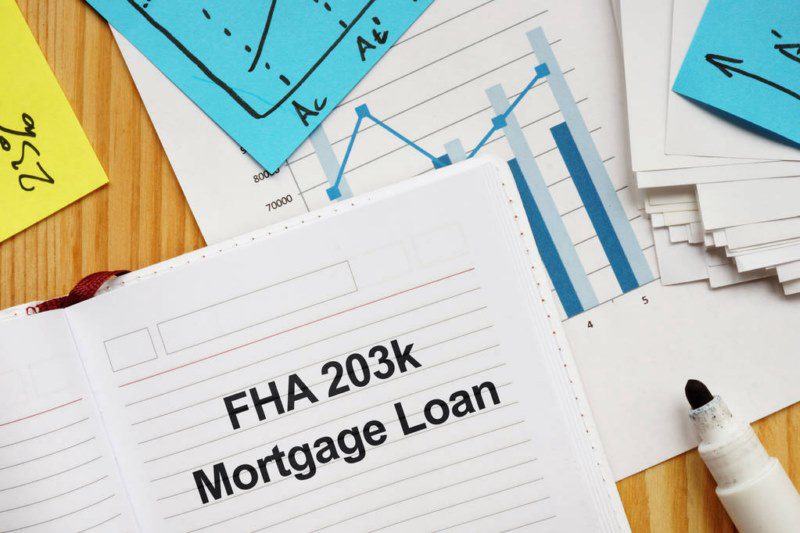Purchasing a fixer-upper home and renovating it into your dream house often requires complex financing to fund both the acquisition and construction. Limited budgets, strict credit requirements, and uncoordinated separate loans can dash dreams faster than faulty plumbing.
Yet aspiring homeowners willing to roll up their sleeves and tackle DIY remodels can access an underutilized loan product unlocking affordable all-in-one mortgages: FHA 203k Loans.
This guide examines how buyers can leverage 203k loans to fund extensive renovations or minor upgrades when buying distressed properties. We’ll navigate the eligibility guidelines, step-by-step processes, project budgeting pointers, contractor tips, pros and cons, and keys to successfully tapping into this renovation financing lifeline.
FHA 203k Loan Benefits – Consolidated Renovation Funding
Traditional home acquisition loans force buyers to handle their actual mortgage and any desired renovations through entirely separate loans. This multiplies complexity. FHA 203k loans solve this through consolidated financing by:
- Covering Both Purchase + Renovations Rather than taking a fragmented, piecemeal approach of trying to coordinate separate traditional mortgage and renovation loans, FHA 203k products strategically blend the financing for both purchasing a home and funding required upgrades or repairs into a simplified, consolidated single loan. This dramatically streamlines overall borrowing requirements for buyers.
- Offering Below Market Interest Rates Due to the fact FHA 203k loans are government-insured lending products, current interest rates buyers can secure are notably lower than competitive private lending market rates. 203k loan rates currently average between approximately 3 – 5% APR fixed rates over the life of the loan. Access to such below-market discounted financing creates significant interest savings over time compared to higher 8 – 10%+ rates common with other renovation loans. More affordable rates allow limited budgets to be stretched further.
- Extending Lenient Repayment Timelines FHA 203k mortgages contain characteristically longer repayment terms than traditional home loans, with maximum durations of up to 30 years for financing single-family homes and condos and 15 years for 2-4 unit dwellings. Such lenient multi-decade lengths for repaying principal and interest significantly reduce monthly payments to more affordable levels for buyers compared to shorter 5-15-year commercial loan terms. Lower payments increase eligibility.
- Limiting Strict Credit Score Requirements By design, FHA 203k mortgage guidelines around minimum credit score eligibility requirements remain reasonably comprehensive, with borrowers possessing credit scores as low as 580 still able to initially qualify for this government-backed financing. For buyers with scores under 580, even larger down payments are just 10% or greater open access as well. It is far more lenient than the tough 720+ score demands of many private lenders.
- Allowing Lower 3.5% Down Payments Prospective homeowners who can meet the minimum 580 credit score threshold for FHA 203k loans are only required to contribute down payments of 3.5% or more of the total purchase price and renovation estimates. Mandating just 10% down, even for poorer credit, allows more financially restricted buyers to enter homeownership. Significantly more attainable than standard 20% convention minimums provide reasonable barriers to entry.
Combined, these advantages make FHA 203k products uniquely friendly options for prospective homeowners seeking ways to fund affordable dream home transformations. But several eligibility rules apply.
What kinds of properties qualify for 203k loans?
203k loans apply to existing residential properties including single-family homes, condos, townhomes, and 2-4 units properties. The property must be located in an eligible area and zoned residential. Commercial properties do not qualify.
Qualifying for 203k Mortgage Approval
To qualify for 203k mortgage eligibility, both properties and applicant profiles must satisfy specific HUD requirements:
Core Applicant Profile Qualifications
- Income & Credit: Middle credit scores start at 580. Debt-to-income ratios below 43% help.
- First-Time Homebuyer Status: Must complete special counseling programs in advance.
- Home Usage: Must reside in the home as primary residence within 60 days of closing for 1+ year minimum.
- Downpayment: Minimum contributions are 3.5% of the purchase price. 10%+ required for lower credit applicants.
Property Parameters for 203k Eligibility
- Residential Status: Must be existing single family, condo, townhome, or 1-4 unit property.
- Occupancy History: Cannot be previously owner-occupied prior to sale.
- Loan-To-Value Ratios: Mortgage capped at 96.5% of post-renovation appraised value.
- Renovation Costs: Total repair expenses are limited to $35,000 before requiring Standard 203k.
Meeting both home buyer and real estate eligibility opens doors to 203k mortgage approvals. We’ll now outline the process itself.
What home improvements are eligible in the 203k program?
203k loans allow extensive remodeling ranging from kitchen/bath upgrades, flooring, roofing, electrical, plumbing, additions, conversions (garage to bedroom), expansions, exterior work like siding, and more. Mandatory health/safety repairs are required first. Luxury upgrades may have limits.

How the FHA 203k Renovation Loan Process Functions
The 10-stage 203k loan process navigates from application to funding dispersal across 6-12 months, with many milestone approvals required:
- Initial Application & Review
The 203k process kicks off with prospective buyers submitting preliminary documentation including income statements, tax returns, credit reports, property inspection permissions, and other financial data required for the lender to vet overall eligibility and lending risks. Lenders analyze applicant creditworthiness, debt-to-income suitability, assets, and income streams and evaluate property parameters.
- Property Inspections
Once initial viability is confirmed, certified FHA inspectors conduct comprehensive on-site evaluations assessing the current physical condition of the entire home. This identifies any urgent health/safety repairs needed, plus catalogs opportunities for renovations. Inspectors determine the feasibility and scope of work and prepare specifications.
- Specification Reports & Bid Requests
The inspectors compile detailed project specification reports outlining appropriate repairs and potential renovations for the home, which serve as the basis for open bid requests to contractors. Specs ensure code compliance and lend guidance on permits required. Bid requests provide itemized project plans for contractors.
- Contractor Selection
Interested contractors must submit final bids with itemized breakdowns of all costs that align with the project specifications shared by the inspectors. Buyers vet and select licensed, bonded, and insured contractors based on pricing within report estimates, expertise, referrals, and other credentials.
- Final Work Approval
Both lending officers and 203k inspectors give final approval verifying that all selected contractors, bids for renovations, actual repair work, project timelines, and total costs remain compliant with program guidelines before buyers can close and funding disbursal begins.
- Loan Finalization & Escrow Funding
The buyer finalizes all loan documents and closing paperwork with lenders for the purchase transaction and renovation financials. The total loan value then funds into an escrow account reserved just for pre-approved remodeling costs, contractor payments, and established contingency reserves.
- Renovation Commencement
Contractors must complete any urgent foundational, roofing, plumbing, or electrical repairs first before aesthetic-based renovations and upgrades formally kick-off. Ongoing inspector evaluations at this work start phase ensure contractors comply with all approval specifications.
- Ongoing Inspections
Throughout the entire active construction process, FHA inspectors consistently evaluate work progress across all projects to guarantee adherence to approved plans with change order approvals as required for any specification deviations.
- Final Inspections & Draw Payments
At the project finish, the inspectors conduct final compliance reviews and approve dispersals of final incremental draw payments from the escrow account directly to the contractors as pre-defined milestones are complete.
- Mortgage Payments Begin
Once the inspectors sign off on satisfactory final renovations, any leftover contingency funds held in escrow are returned to buyers to apply toward paying down the mortgage loan principal. Owners officially begin their long-term mortgage payments.
This rigorous process ensures renovations meet courtroom standards. Now, let’s examine budgeting financials.
What are the credit score and down payment requirements?
Minimum credit score is 580 for 3.5% down payments. Below 580 scores require 10% or more down. First-time buyers also need housing counseling. Loan-to-value ratios go up to 96.5% of post-renovation home values.
Estimating Accurate 203k Renovation Budgets
Creating conservative line-item renovation budgets with contingency buffers is critical when applying for 203k loans. Key cost considerations include:
- Mortgage Downpayment
The downpayment requirement for 203k loans ranges between 3.5% to 10% or more based on the total purchase price of the home. Minimums correlate to credit scores, with buyers meeting 580 FICOs needing just 3.5% down. Funds are due at closing.
- Closing Costs on Financing
All standard closing fees charged on mortgage loans also apply to 203k products, costing approx 1% to 5% of the total principal amount borrowed. Typical expenses include origination charges, appraisal fees, credit checks, processing fees, title insurance, and taxes.
- Inspection & Monitoring Fees
Applicants must budget for all required FHA consultant property inspection fees to assess repairs/upgrades plus ongoing progress inspections during renovations. Typically, it costs over $300 per site visit, with frequent visits mandated. It can add up quickly.
- Contractor Bids
Itemized contractor renovation expense breakdowns accounting for all labor, materials, permit fees, site preparation, subcontractor management, warranties, clean-up, and profit margins must align with budget estimates. Verify transparency.
- Contingency Reserve
All 203k mortgages require setting aside 10-20% extra cushion of total renovation estimates to cover any unexpected overruns mid-project. Unused reserves get returned as principal prepayments after finishing renovations.
- Unexpected Cost Overruns
Despite meticulous planning, older homes often uncover hazardous material removal, rot repairs, and outdated electrical or plumbing issues missed on initial inspection but required for occupancy. Pad estimates.
Tracking expenses against projections and adjusting bids guarantees sufficient funding is available through the full fixer-upper transformation process.
Vetting Contractors for 203k Projects
Another lynchpin determining 203k success is vetting skilled contractors for renovations. Key traits to seek include:
- Proper Licensing All general contractors and specialty subcontractors must meet state and local licensing requirements and prove proper credentials to perform home improvement projects legally. Similarly, bonding and insurance policies must cover project values and risks. Confirm all compliant paperwork.
- Itemized Bid Breakdowns Contractor bids must contain detailed itemizations of all costs including a clear separation of labor rates, material units/costs, applicable permit and inspection fees, warranties, project timetables/schedules, clean-up, and profit/overhead. Define all roles.
- Strong References Do research vetting contractor previous project reviews on referral sites like Angi and personal references to evaluate experience, quality results, customer service history, and complaints for insight into potential issues before selection. Avoid brand-new contractors without track records.
- Specialized Project History Seek contractors and firms specializing in categories of renovations matching your specific kitchen overhaul, bath updates, garage conversions, electrical rewiring needs, etc, rather than generic firms. Niche expertise improves outcomes.
- Willingness to Manage Subcontractors For extensive renovations, a general contractor’s ability to securely manage and coordinate various specialty trades like plumbers, roofers, landscapers, etc, in compliant and timely ways simplifies project complexity for homeowners through a consistent point person.
Investing ample time in vetting contractors prevents headaches when renovations inevitably uncover surprises requiring skill, diligence, and expertise to address.
Weighing FHA 203k Loan Pros vs Cons
While 203k loans unlock doors for affordable homeownership dreams, they come with limitations to factor:
Pros
- Consolidates purchase + renovations
- Low interest rates
- Limited credit score requirements
- Lower down payments than conventional loans
- Lengthened repayment timelines
Cons
- The steep learning curve, given the complexity
- Lengthier approval process than standard mortgages
- Higher upfront and ongoing fees
- Overruns risk loan amount caps
- Home harder to sell mid-process
- Lots of required inspections
Carefully evaluating both the advantages and drawbacks helps set proper expectations when utilizing 203k mortgages to finance home transformations.

Keys to 203k Approval & Avoiding Pitfalls
Follow these best practices when applying for 203k loans to smooth the process:
1) Documentation Diligence
Thoroughly supply all required financial statements, renovation plans, bids, permits, etc., quickly up-front.
2) Realistic Budgeting
Avoid optimism bias and give reasonable projections for both purchase prices and project costs.
3) Local Lender Experts
Find lenders experienced specifically guiding buyers through 203k loans to shortcut hiccups.
4) Attention to Detail
Closely adhere to compliance rules and be ready to supply clarification documentation.
5) Contractor Rapport
Create open contractor relationships and communication channels from the start.
The complexity of 203k loans means diligent preparation prevents struggles as home and life renovations get underway.
Conclusion – Funding Dreams Through FHA 203k Loans
Funding homeownership dreams often requires compromises between move-in-ready affordability and houses meeting all desired features. For hands-on buyers willing to embrace long-term gradual DIY transformations through 203k loans, more possibilities emerge.
Albeit daunting initially, 203k mortgages consolidate financing to fuel dreams without draining budgets. As veterans of some 1.5 million 203k loans issued over the past 30+ years can attest, this underutilized funding product unlocks potential for not just enhancing living spaces but also building financial equity.
Yet qualifying requires diligence. Processes mandate organizational prowess through months of contract coordination, culminating in realized visions. Ultimately, passion for the before-and-after metamorphosis fuels drives through bureaucratic documented dances towards keys to new castles.
But for qualifying buyers willing to embrace the 203k path less traveled, milestones bring both upgraded abodes and a sense of pride only sweat equity delivers. Not financing furniture delivers. Because when you resurrect the forgotten, neglected, and abandoned, you further community continuity by upholding pillars of existing foundations.
This signifies more than saving sunk costs. It parallels finding diamonds in the rough – unlocking hidden potential. The fruits of 203k laborers’ gift not only achieved dwellings but also hands-on education and skill building to carry forward.
While daunting, FHA 203k loans enable more stimulated minds to tackle more fixable houses. And this process graduated to existing dwellings what internships offer budding professionals. Structure mixed with creativity cultivated through connection to dwellings, neighborhoods, and towns.
This goes beyond four walls and a roof – it represents opening doors for more footnote family legacies cached into more community fabrics. And this matters well beyond loan principal balances and demolition dust…it returns forgotten relics into renewed sanctuaries brimming with making merry.
The colliding worlds of financing and families realized – this powerful potion remains ripe for the inspired taking. Does your next chapter, Kanban, between the covering bonds of shared walls with rich stories yearning to exhale again? If so, FHA 203k loans may provide your special starter elixir to toast a new world, one nail, one paint brush, and one resilient remodel at a time.
Let’s collectively regain time by reclaiming spaces…and unlocking community continuity through unwavering personal grit, one fixer-upper at a time! The ride won’t be easy, but the rewards can’t be matched either. Game on!
How much additional paperwork is involved verses standard mortgages?
203k loans require extensive additional paperwork like architectural plans, engineering specifications, contractor bids, permits, and more. Applicants should expect a lengthy underwriting and approval process spanning approximately 6 months.

